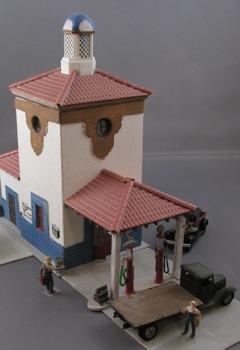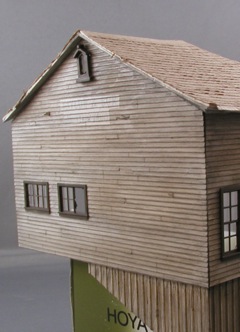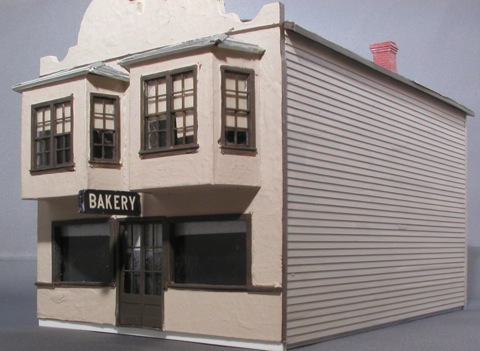I grew up in the San Francisco bay area, and grew up wandering through the old downtowns of suburban San Francisco communities like San Bruno, South San Francisco, and Millbrae. I visited grandparents in the East Bay, and saw pictures of the old family fruit ranch in Hayward. I learned how to drive in the industrial parks of South San Francisco as well as the roads winding through the Santa Cruz Mountains. I saw all sorts of buildings. Sometimes I'd see traditional houses built before the turn of the century that resembled the buildings seen elsewhere in the US. I saw all the Spanish Revival, Mission Style, and Berkeley brown-shingle buildings from the 'teens. I saw the modern and art deco buildings of the twenties (and the cleaned up, modern San Francisco townhouses of San Francisco's outer Sunset)2. Scattered through many of the old neighborhoods, I'd see a mix of all of these.


Spanish-revival Rio Grande gas station, originally in Santa Barbara, California. Built from plans in a 1970's era Model Railroader magazine; wooden packing shed based on buildings in Wrights, California. The original was probably built of redwood milled within a couple miles of the building site. The board and batten skirting protected the posts which propped this building up above a creek bed.
Unfortunately, none of these sorts of buildings are found in the typical manufacturer's set of buildings. There's tons of brick buildings for your midwestern main street, or towering warehouses, tenements, high-peaked roofs, classical pillars, and covered stairwells and mud rooms.
What do I want to see? Look, for example, at this picture of San Mateo Ave. in San Bruno, a suburb of San Francisco. The center building is Spanish Revival because of the curved line of the stucco facade; behind, it's brick or (more likely) wood. The rest of the buildings are all one story, and none appear very architecturally significant except for that great curved-roof grocery store halfway down the block. Or look at this photo of a parade with a grocery store behind. Again, modest buildings, stucco false fronts with the rest of the building in clapboard siding, or Bank of America's modest art deco bank building suitable for a smal town? (I've probably seen the same bank building in a few other towns along the peninsula.)
What makes a building Californian?
- Very little brick. Unreinforced brick buildings fall apart in major earthquakes, so Californians quickly learned that brick buildings were bad. You'll still see older brick buildings in California, but in general brick fell completely out of favor by the time the Long Beach earthquake stopped shaking in 1933. Unfortunately, it must be easy to make good-looking brick buildings in plastic, and so the manufacturers have lots of buildings to sell us. Sorry, that's not what my main street looked like!
If there are brick buildings, they usually predate the 1906 San Francisco earthquake or (at worst) the 1933 Long Beach earthquake. For extra realism, place some some steel plates just below roof level with nut-bold-washer castings in the center to represent the reinforcing rods that pull the sides together and keep the walls from falling over during an earthquake. Your HO figures deserve your caution! - Lots of wood. Wood-frame and sheathed buildings were cheap and easy to build in California; there were huge forests along the coast range and in the Sierra Nevada Mountains. San Francisco recovered quickly from the 1906 earthquake because lumber from the Mendocino coast and from the Santa Cruz mountains quickly arrived for rebuilding. It's not at all unusual to find older industrial buildings built completely from wood.
- Single story, low and big buildings. Land was cheap in small-town California, so low buildings that spread out were common. Stairs, after all, are a lot of trouble; if you can buy a big lot and put a spreading building on it, why not? With the mild winters, there also was less worry about heating the building. The buildings also stay low to the ground. Because the ground doesn't freeze in California, there's no need to dig the foundations below the frost line. Placing buildings directly on slab is safe and cheap.
- Less enclosed storage, more outdoor work space. Because of the mild climate, it's not surprising to see equipment stored outside, or for a building to be open on one end. Houses won't have mudrooms, and will often have large porches to catch breezes during the summer. Large, overhanging eaves keep the heat out in the summer. (Watch out, though, for the steeper roof lines and big eaves from Colorado or New England; those roof slopes aren't needed when you're not trying to encourage the snow to slide off.)
- Less substantial industrial buildings. Most California towns had industries that were seasonal like agricultural, or were new businesses that built light buildings. There were few of the huge industries that might build large, permanent buildings, nor was land expensive enough to force owners to build up. As a result, it's not surprising to find wood-framed or corrugated iron buildings instead of large brick warehouses and factories.
- Lemon trees. Every house in California needs to have a lemon tree planted somewhere on the property. It's a zoning requirement that's strictly enforced.
What kits do I like? The old Suydam kits (now made by Alpine Division Scale Models) have some of the best California lines. Their lumber yard shows how mild weather kept most of the lumber exposed and the office small. Suydam also made two of the only Craftsman-style houses in HO with their Dr. Whyte's house and Brown's Bungalow. Both would be at home in any suburban town in Northern California. The cardboard kits require a bit of care, but turn into nice models. Timberline Scale Models also produced a beautiful laser-cut Craftsman bungalow kit back in 1998, and my model sits proudly front-and-center on my Market Street layout. Campbell's wooden kits also capture the California look-and-feel with lots of low wooden and corrugated iron buildings. Some look a bit too rustic, but that's nit-picking. All Campbell's buildings also have wide eaves and lighter construction which makes them look more Californian than many of the wood kit manufacturers. Compare Campbell's kits to Bar Mills's kits, for example.
There's also few kits for the art deco and streamlined moderne styles that were common in the 1930's. Walther's bus terminal or City Classic's market would both fit the Bay Area well. IHC's San Francisco townhouses provide material for kitbashing any of the stick-style townhouses seen in Northern California urban cities. Although the townhouses might have been two or three stories in San Francisco, these can also be cut down to a single story. Finally, I love Showcase Miniature's barn, which looks exactly like a typical barn you'll see in rural California even today. Those Iowa-style barns with mansard-ish roofs just don't appear out here.
I model the 1930's, but if I modeled the 1950's or later, I'd also need to put in mobile home parks. Mobile home parks in California were often built on the undesirable land that was easily graded, so it's common to see clusters of mobile homes in odd shaped lands along creeks or in other places where flooding appears frighteningly possible. Usually, the railroad went by the same spot.
I'd love to see more California-style buildings. Spanish revival style buildings are really common on the San Francisco peninsula, yet I can't think of more than a couple kits with tile roofs. I'd love to see some embellished false fronts with stucco and red roof tiles hiding a worn wooden building behind. I've built one by routing the facade from plexiglas and building bay windows from styrene. Model Tech Studio's kit for the San Francisco's 4th and Mission switch tower is beautiful (and I wish I'd get around to building mine.) I'd also like to see more art deco building kits; I've always been interested in Funaro and Camerlengo's art deco building, but have never gotten around to buying or building one.

Spanish-revival storefront with bay windows, modeled from building in Campbell, California. Front wall is plexiglas milled to shape; rest of body is styrene sheet.
Now, my other pet peeve are buildings that are asymmetric, badly balanced, or look too crazy to have ever existed, but I'll save that rant for another day.
Here's details on a few of the structures I've built for my layout that look like California buildings: